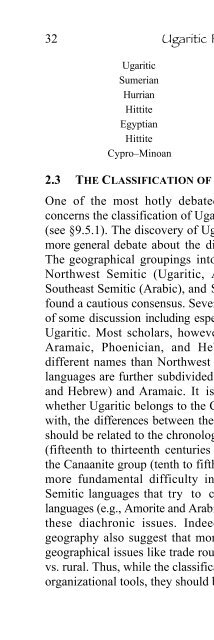A Primer on Ugaritic: Language, Culture, and Literature - enenuru
A Primer on Ugaritic: Language, Culture, and Literature - enenuru
A Primer on Ugaritic: Language, Culture, and Literature - enenuru
Create successful ePaper yourself
Turn your PDF publications into a flip-book with our unique Google optimized e-Paper software.
32<br />
<strong>Ugaritic</strong> <str<strong>on</strong>g>Primer</str<strong>on</strong>g><br />
<strong>Ugaritic</strong> Cuneiform<br />
Sumerian Cuneiform<br />
Hurrian Cuneiform<br />
Hittite Cuneiform<br />
Egyptian Hieroglyphic<br />
Hittite (Hittite) Hieroglyphic<br />
Cypro–Minoan Cypro–Minoan Script<br />
2.3 THE CLASSIFICATION OF UGARITIC<br />
One of the most hotly debated questi<strong>on</strong>s in <strong>Ugaritic</strong> studies<br />
c<strong>on</strong>cerns the classificati<strong>on</strong> of <strong>Ugaritic</strong> within the Semitic languages<br />
(see §9.5.1). The discovery of <strong>Ugaritic</strong>, first of all, reenergized the<br />
more general debate about the divisi<strong>on</strong>s of the Semitic languages.<br />
The geographical groupings into Northeast Semitic (Akkadian),<br />
Northwest Semitic (<strong>Ugaritic</strong>, Aramaic, Phoenician, Hebrew),<br />
Southeast Semitic (Arabic), <strong>and</strong> Southwest Semitic (Ethiopic) has<br />
found a cautious c<strong>on</strong>sensus. Several languages are still the subject<br />
of some discussi<strong>on</strong> including especially Amorite, Eblaite, <strong>and</strong> even<br />
<strong>Ugaritic</strong>. Most scholars, however, group <strong>Ugaritic</strong> together with<br />
Aramaic, Phoenician, <strong>and</strong> Hebrew though sometimes under<br />
different names than Northwest Semitic. The Northwest Semitic<br />
languages are further subdivided into Canaanite (e.g., Phoenician<br />
<strong>and</strong> Hebrew) <strong>and</strong> Aramaic. It is again a hotly debated questi<strong>on</strong><br />
whether <strong>Ugaritic</strong> bel<strong>on</strong>gs to the Canaanite group or not. To begin<br />
with, the differences between the <strong>Ugaritic</strong> <strong>and</strong> Canaanite languages<br />
should be related to the chr<strong>on</strong>ological differences between <strong>Ugaritic</strong><br />
(fifteenth to thirteenth centuries BCE) <strong>and</strong> the main evidence for<br />
the Canaanite group (tenth to fifth centuries BCE). This points to a<br />
more fundamental difficulty in categorizati<strong>on</strong> schemes of the<br />
Semitic languages that try to classify chr<strong>on</strong>ologically disparate<br />
languages (e.g., Amorite <strong>and</strong> Arabic) without adequately addressing<br />
these diachr<strong>on</strong>ic issues. Indeed, linguistic studies in dialect<br />
geography also suggest that more attenti<strong>on</strong> needs to be given to<br />
geographical issues like trade routes, coastal vs. inl<strong>and</strong>, <strong>and</strong> urban<br />
vs. rural. Thus, while the classificati<strong>on</strong> schemes may be c<strong>on</strong>venient<br />
organizati<strong>on</strong>al tools, they should be used with these caveats.


